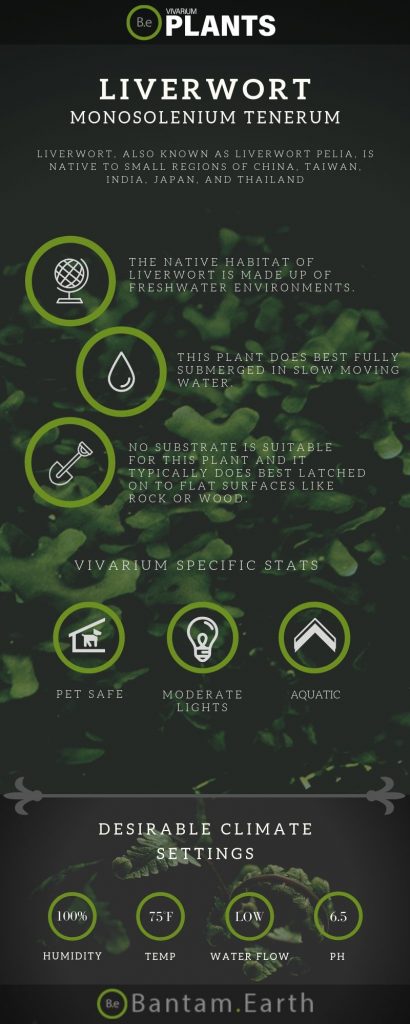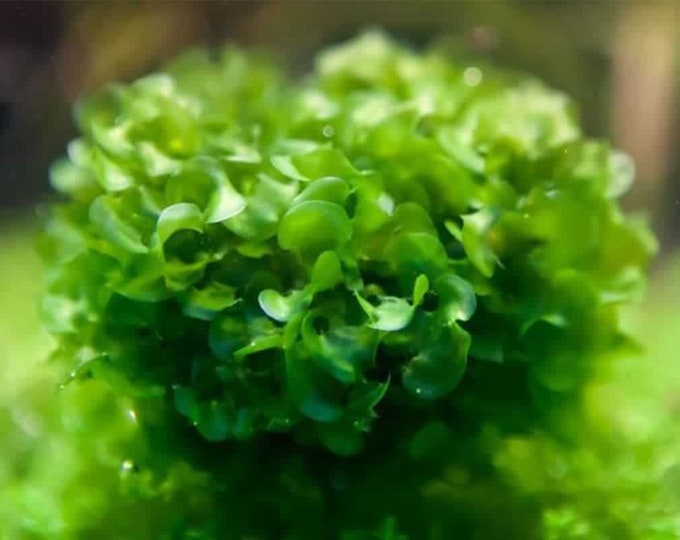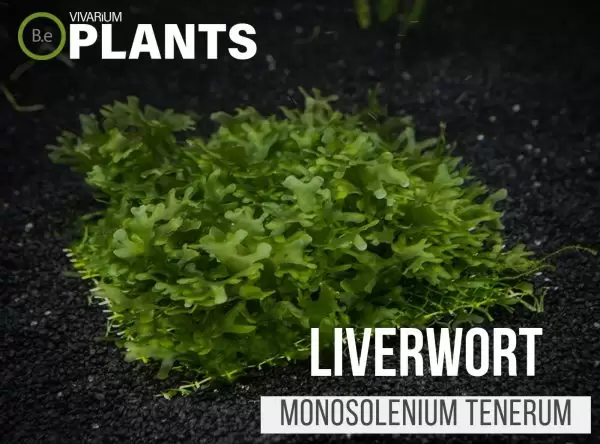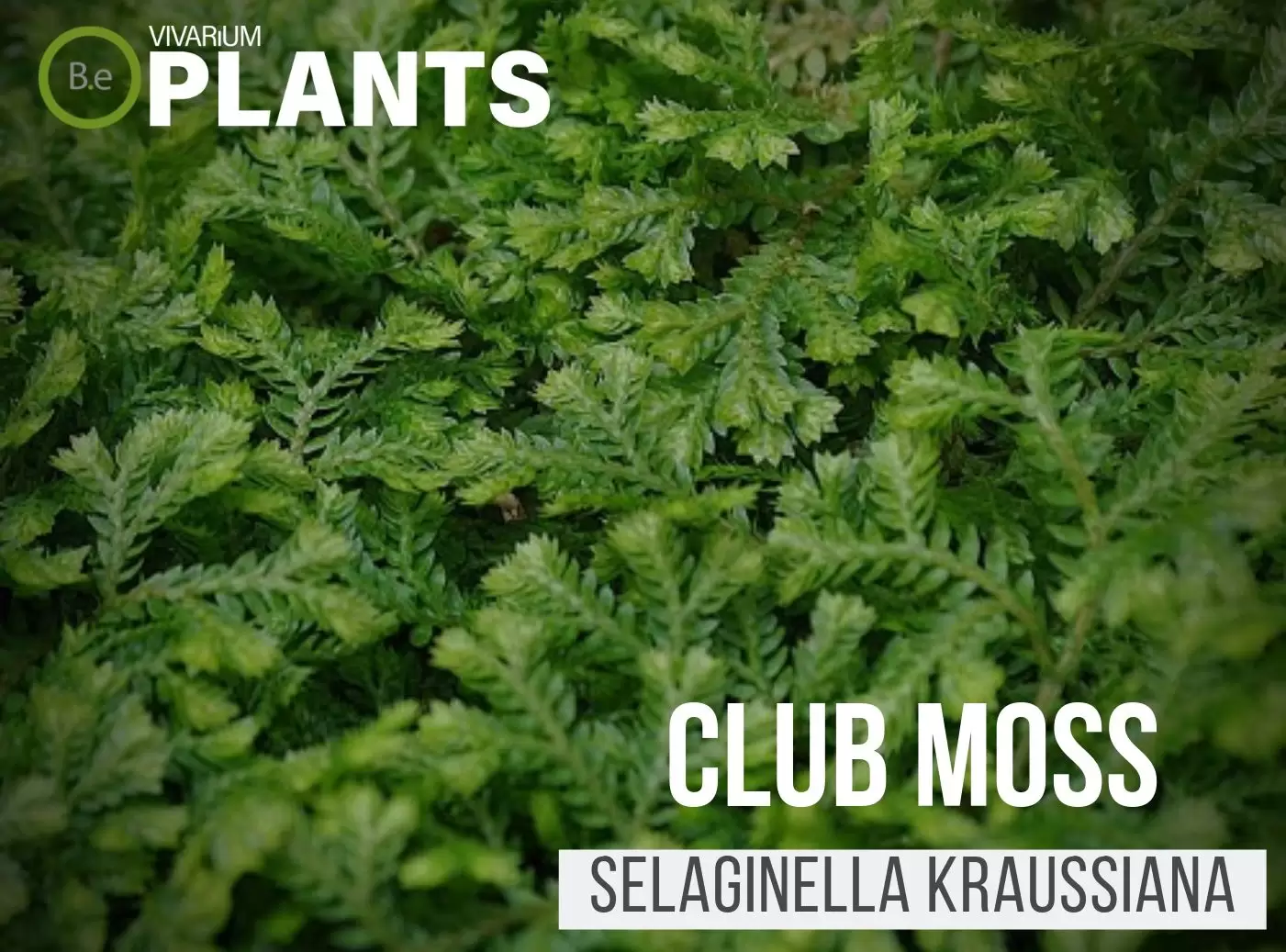Liverwort (Monosolenium tenerum) is a freshwater aquatic plant that is mostly used as a carpet at the lower end of aquariums.
This plant is actually very similar to Riccia Fluitans, more commonly known as Crystalwort.
Many hobbyists describe Liverwort as a magnified and significantly larger version of Crystalwort.
Unlike Crystalwort, Liverwort is generally heavier than water and therefore remains fully submerged.
| Quick Stats: | |
|---|---|
| Scientific Name | Monosolenium tenerum |
| Common Name | Liverwort, Liverwort Pelia |
| Family Name | Monosoleniaceae |
| Habitat | Freshwater |
| Temperature | 40°F to 80°F |
| Height | 1 to 4 inches |
| pH | 5.0 to 8.0 |
| Lighting | Low to medium |
Table Of Contents:
ToggleWhat is Liverwort?
Liverwort, scientifically known as Monosolenium tenerum, is an aquatic plant very close to the moss family.
Despite its striking similarity, this plant is not an actual moss, but rather a part of the Liverwort genus.
This plant was originally mistaken and labeled as Pellia or Pelia. It wasn’t until sometime after Liverwort was discovered that it was properly labeled and categorized into its own species.


Liverwort Facts
As mentioned before, Liverwort was sometimes referred to as Liverwort Pelia. In fact, some people still call it by that name today.
Unlike other plants, Monosolenium tenerum does not technically have leaves. The green part of the plant that looks like leaves are actually known by plant scientists as thallus.
Each thallus will divide into fork-like branches to create a cushion type of growth. Liverwort is a fairly easy plant that will not have huge demands on an aquarium environment.
Description
Liverwort could be best described as a darker, larger, sinking version of Crystalwort. It is still a considerably small plant that grows flat.
Liverwort can be usually seen attached to trees, rocks, or logs, just like moss does.
This plant has the ability to grow in long ribbons or smaller clumps and got its name because it was believed to resemble a human liver.
Liverwort is a heavier plant, which keeps it towards the bottom of a tank in vivid-looking cushions. The plant will use a root-like system called rhizoids to anchor itself to most surfaces.
Habitat
Monosolenium tenerum is native to small regions of China, Taiwan, India, Japan, and Thailand. Unlike most mosses, they are extremely rare in the wild and not as easy to find.
Most of the Liverwort sold today comes from botanists that grow it themselves.
They require a lot of water and are usually found in damp areas or completely underwater. As long as there is plenty of water, Liverwort has the ability to tolerate very harsh climates.
It can grow in rather cold areas as well as the tropics, flourishing in temperatures anywhere from 40 to 86 degrees Fahrenheit.
Despite its ability to withstand cold climates, it will grow best in warm-temperate to sub-tropic areas.
PH Preference
Liverwort is not very picky when it comes to its environment. It can grow in either hard or soft water and its ideal pH levels will range from 5 to 8.
This is one of the qualities that make it such a desirable vivarium plant for some aquarists looking to decorate their tanks.
Vivarium Placement
Monosolenium tenerum is an aquatic-based plant that requires a lot of water. With that in mind, the plant will not survive if it’s kept in dryer areas of an enclosure.
Most hobbyists will place Liverwort in the fore or midground of an aquarium.
Since this plant is heavier than water, it will not be able to be used as a floating decoration.
Liverwort is usually seen on aquariums attached to rocks or pieces of wood in a cushion-like shape.
Vivarium Type
This type of plant will do great in a variety of vivarium types. When deciding if rather or not to use Monosolenium tenerum in a particular type of enclosure, be sure to go with setups that can provide a moist/tropical setup.
Here are recommended vivariums Monosolenium tenerum will do well in:
- Paludariums – Half aquatic/ half terrain-based enclosure.
- Ripariums – Mostly aquatic-based enclosures with some terrain features present.
- Aquariums – Fully aquatic-based enclosure with no terrain features.
Substrate
Unfortunately, Liverwort does not attach to any aquarium substrate too well. Unlike its counterpart, this plant can break off easily and scatter around the tank.
For this reason, some choose to use thread or fishing lines to keep it well attached to a specific surface.
Lighting
Liverwort can thrive in both shade or full sunlight environments. However, exposing this plant to too much direct sun or heat will dry and burn it out.
Liverwort will grow much more robustly and look far more attractive in setups with ample light.
When setting up lighting within an aquarium, a high level of brightness would be ideal.
Buy Liverwort
When shopping for possible liverwort for sale, expect a few key indicators you are buying the best quality plant.
The flora should be algae & snail free along with any other type of pest. The source of liverwort will usually be sold in small tissue cultures, ready for you to propagate.
The batch should arrive fairly moist and in fairly good shape. Click the image below to find out more about the current price and other relative info:


Liverwort Care and Propagation
When it comes to care and propagation, Liverwort is not an overly complicated plant. As long as there is good water quality it should be just fine.
This is a plant that grows outwards and uses spores to reproduce.
These spores will grow on the tip of stems and blow off allowing the plant to spread out. The process will continue on its own to make sure that the flora multiplies correctly.
How to grow
Liverwort can be grown in a moist terrarium, aquarium, or in small plastic boxes on the windowsill, as long as it is not too hot.
These locations allow for better-controlled growth conditions and modifications to allow as much expansion as possible.
A good source of light and some added CO2 can kick liverworts’ growth rate to an accelerated new level.
The most effective method to cultivate Liverwort is pretty much the same as Crystalwort. The parent plant should be divided into smaller pieces and then be tied down to a mesh or surface with thread or fishing string.
Doing so will ensure that the flora remains attached. Liverwort is known for breaking off and dispersing throughout the tank.
Those pieces should also be able to regenerate on their own. Although, such an occurrence can create some unwanted disarray in an aquarium.
Watering
Liverwort is a type of plant that will require a large quantity of water. When grown submerged it will not need to be watered. The plant will be able to absorb as much water and nutrients as it needs on its own.
Unlike Crystalwort or most mosses, Liverwort will not benefit from a steady water flow. Since the plant can break off easily, too much water movement can make the situation worst.
Plants Similar To Liverwort
Adding diversity to an enclosure is key to an aesthetically pleasing enclosure. Try mixing up the look of your vivarium with different flora that can easily co-exist in the same types of environment.
Furthermore, if for some reason you find liverwort hard to acquire or would like to consider something similar to this plant…
Here are some other plants you might find very similar to Monosolenium tenerum:
Conclusion
Overall, I believe Liverwort is a relatively easy plant to have in an aquarium. It can survive some pretty harsh conditions and serve as a great aqua-scaping tool. One thing to keep in mind is the type of fish that you plan on incorporating into the enclosure.
Monosolenium tenerum is apparently not eaten by fish, but the fish can swim around in the plant and spread it around creating a mess.
Less active or destructive fish would probably be a better idea, in order to preserve the plant as much as possible.
Frequently Asked Questions
Yes, you can eat Liverwort (Monosolenium tenerum). This type of edible moss is most commonly eaten raw, in salads, as a garnish, or cooked. Liverwort is a high–fiber food and is a source of vitamins A, C, and E. It is also known to contain a variety of minerals and other antioxidant compounds.
No, Liverwort is not a problem. Liverwort is a small, non–parasitic plant, which usually has a mossy, cushion–like appearance. The plant is considered beneficial for aquatic ecosystems, as it helps to filter and reduce the levels of pollutants in the water. As such, the presence of Liverwort in bodies of water is not cause for concern.
No, Liverwort (Monosolenium tenerum) is not a problem to plants. It is a small, non–flowering plant that is often mistaken for a weed. Liverwort generally only grows in moist, shaded areas. It does not typically compete with plants and does not contain any known toxins, making it harmless to plants.
No, Liverwort (Monosolenium tenerum) is not a fungus. It is a type of plant classified as a bryophyte.



